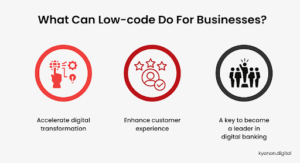Because of the effect of Covid-19, the way that low-code automates processes in the banking industry has been one of the biggest points of concern recently.
Why have low-code solutions gained more ground in the IT world of financial firms? Will low-code be a key point and the future for the development of the banking industry?
The COVID-19 global crisis has brought about many new challenges to all organizations around the world. No organization could predict or prepare for it; especially, the banking industry which had very little time to deal with the challenges, and adapt to the changes. Banks are trying to keep up with the particular changes brought on by the pandemic, as employee and consumer behaviors have drastically changed, and shifted comprehensively towards online where they can get their most pressing needs met. Of course, this requires that businesses boost their digital capacities to respond to customer needs quickly by turning to automated processes.
Low-code is an ideal solution for the banking industry right now. Low-code is agile, adaptable, scalable and rapid. It could help businesses meet the consumer needs as well as any unpredictable future challenges as the pandemic is not over yet and the environment is dynamic.
Let’s consider why banks should go for low-code.

1. What role does low-code play in automated processes?
Low-code is not just a technological upgrade, it changes the entire banking experience for the better by encouraging innovation, shifting focus to customer experience, and challenging all legacy processes. Low-code creates transparency, and provides users with the tools to reduce technical requirements and enhance innovation. It also provides banking firms with the speed and power to improve customer experiences, staff productivity, business success, and come closer to what digital transformation looks like in practice.

2. What can low-code do to automate processes?

2.1. Low-code – Accelerate Digital Transformation
Nowadays, many banks are on the path of digital transformation. Modern customers now expect digital banking products and services more and more since Covid-19 has restricted physical contact and face to face meetings. Therefore, banks now have to speed up their digital transformation as fast as possible, and keep things up to date in order to meet customers’ needs and expectations in the post-pandemic world.
However, despite digital change, banks still use traditional software development, which is long and expensive. They might spend months on developing, testing, and deploying an application. In this digital world, time is key and banks who provide faster time-to-market products and services can win customers’ loyalty. Low-code is the best solution.
Low-code platforms enable banks to rapidly develop and deploy applications in just a few days, and launch digital solutions as quickly as customers expect. Low-code accelerates digital transformation in banks.

2.2. Low-code – Enhance Customer Experience
As we can see, most banking customers want personalized products and services that are customized to their needs, locations, and devices. If banks can provide an enhanced customer experience, they can acquire more new customers and retain their existing customers.
Low-code app development platforms make banking services and processes simple and easy, by enabling apps for digital accounts and digital loans. Banking processes that usually take days could be done in minutes as low-code banking apps that enhance customer experience can be built quickly and efficiently.
Low-code platforms make it simple to connect to many data sources, regardless of the connection technique, allowing you to do in-depth research on your consumers, finances, or production data and use the existing data to customize products and services based on each customer. Low-code platforms also enable banks to apply omni-channel methods, which can allow users to have all transactions done on the digital device of their preference.

2.3. Low-code – A Key to Become A Leader in Digital Banking
Digital banking is the ideal type of banking in today’s digital world. In order to be successful, banks need to prepare and plan for future unpredictable events caused by the dynamic circumstances. Banks need to leverage advanced technology to unlock the whole potential of digital transformation and deliver the best customer experience. They need solutions that can generate real-time data features for tracking and monitoring. They are also able to provide predictive insights to plan and strategize future goals. Low-code is the key to helping banks become leaders in the digital game.
Low-code development platforms leverage data, AI, and advanced analytics to build advanced apps that offer predictive analysis and personalization. Banks can use these low-code app capabilities to tailor their websites, provide real-time banking recommendations, and even test advanced future-proof banking services.

Let’s take a look at one of the primary case studies demonstrating successful low-code development in Bendigo Bank, one of the largest banks in Australia. Bendigo Bank wanted to turn its attention to advanced customer service. This required the company to have new positions to be able to improve customer service. Unfortunately, this greatly increased the overall workload that the business had to deal with. To deal with the new challenge, Bendigo Bank turned to a low-code RAD (Rapid App Development) platform, an excellent solution for creating business-related apps.
Using a low-code platform, Bendigo Bank created 25 customer-centered apps in about a year and a half, considerably less time and much cheaper than normally required when hand-coding similar apps. Most of the apps were absolutely critical to the day-to-day tasks the bank performs thereby leading them to become one of the leaders in the banking industry nationwide.
3. Automated processes in the banking industry with low-code
Low-code is globally driving innovation, it is rapidly becoming a necessary part of the digital workplace charter and is the default method for institutions building software today. Kyanon Digital leverages low-code development expertise when rapidly building scalable applications that modernize IT and help achieve the goals of speed and agility.
With significant experience in delivering digital process automation solutions and financial domain capabilities, we can help you easily and efficiently create, launch, use, change and expand enterprise applications and speed up your enterprise application development. Kindly contact us to know more about our solutions and to get your digital transformation journey started effectively and successfully.
Kyanon Digital is delighted to be a solution partner for Mendix. We have an excellent and experienced team of highly trained developers and consultants who create custom applications that are faster, simpler, and more cost-effective than traditional development techniques. With the goal of providing the greatest and fastest solutions, Kyanon Digital will help integrate your digital transformation with the Mendix low-code platform effectively and successfully.




